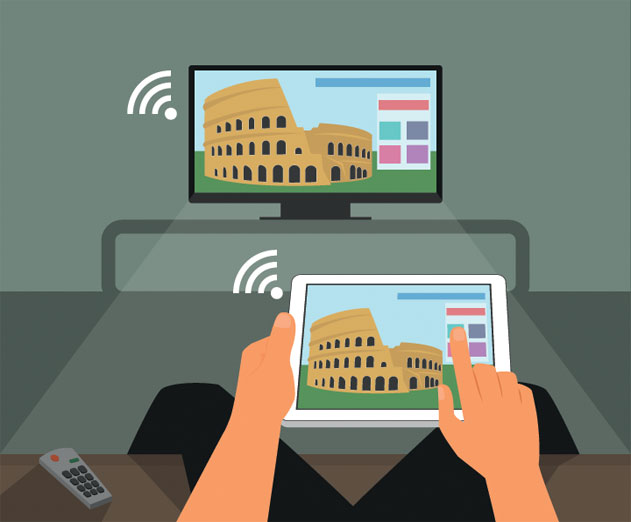Creating a Rich Second Screen Experience
Saturday, July 19, 2014

|
Sean Bowen |
We've reached the point with “second screen” viewing where the term itself may even be outdated. Most U.S. consumers today use a mobile device while simultaneously watching television – only 12 percent of tablet users and 14 percent of smartphone users are the exception, according to Nielsen. Is it time to just accept that there's no longer anything "secondary" about these non-TV screens?
Mobile devices have transformed television viewing from a passive one-way experience, to one that brings fellow consumers into our living rooms, with whom we can constantly interact and engage. Users now expect to be offered a second screen experience.
Yet, the possibilities for augmented TV viewing are not limited by creative ambition, but rather by the back-end development of the mobile applications that make the experience possible. How can these applications deliver rich, real-time experiences while scaling to millions of TV viewers, even in the face of fluctuating user demand and connectivity challenges? After all, if a second screen app isn’t fast enough for speed-hungry consumers, or breaks sometime during the 30 or 60 minutes viewers are watching a program, it’s going to be quickly deleted from their devices.
The Wild West of Second Screen Apps
It’s one thing to check your phone during your commute to work or when waiting for an appointment, but Americans now stay connected to their mobile networks even during downtime activities. In fact, about 50 million smartphone and tablet users are engaging with second screen content at least once a day.
Technology has reached a level of cultural immersion that has transformed today’s consumers into digital connoisseurs who are able to constantly engage with brands and media. Five years ago, Ellen DeGeneres' Oscars selfie would not have received a record number of retweets, Oreo's Super Bowl "Dunk in the Dark" tweet wouldn't have gained them an additional 33,000+ Instagram followers, and “American Idol” wouldn't have been able to use Facebook voting data to give viewers real-time contestant rankings during a broadcast.
Because of the popularity of second screens, everyone has an app for enhanced TV viewing – mainstays like Facebook and Twitter; some prominent social platforms you might not expect like the "Project Runway"-supported Pinterest, or the expanding i.TV; television networks like AMC’s Story Sync app and NBC’s Winter Olympics app; and even cable and Internet providers that have tried to monetize second screen interactions.
Yet, despite this fragmentation, there’s one unifying factor all second-screen providers need to focus on – ensuring the scalability, reliability and speed of their apps. Second screen is second nature for TV viewers, and they’ve used them so often that they know how these apps should function. So, if an app fails to load quickly or shuts down unexpectedly, due to an overtaxed network or some other performance issue, users will simply find another one to occupy their need for multiple screens.
All of this can be avoided, though, if mobile app developers are able to meet the technical challenges that hinder scalability, reliability and speed.
The Downtime Downside
As with anything that becomes exceedingly popular in a short amount of time, second screen applications do not always perform perfectly.
Anyone who has ever checked their fantasy football team from their tablet while watching a full slate of Sunday afternoon NFL games knows the frustration of seeing your running back rush into the endzone, but not knowing whether that touchdown helped you win your matchup because your app didn’t update. It’s easy to understand why this happens so frequently – the application was driven beyond its capacity.
According to the Fantasy Sports Trade Association, 13 percent of the U.S. population over age 12 plays fantasy sports, and, among those who use an accompanying fantasy sports mobile application, 67 percent use their devices to access information about statistics or players in real-time. That’s an enormous load to be placed on any mobile application, which often experience latency and outages when maximum capacity is surpassed.
In this case, back-end app development procedures did not sufficiently take into account the peaks and troughs in end user demand, or the expectation for speed and real-time performance. So, how can app developers optimize the user experience and solve these challenges that come with second screen apps?
Intelligent Data Distribution Delivers Unmatched Second Screen Experience
The fantasy football example speaks to some of the most common problems that prevent optimal second screen performance, all of which can be prevented if app developers transform their second screen strategies with an intelligent data distribution solution.
Applications that are developed to intelligently understand data deliver a rich user experience, supplying the right information to users’ device of choice, at the right time. This means finding out from a fantasy football app that your wide receiver has been suddenly benched just before kick-off, allowing you pull off a last-minute substitution.
Such an improved user experience can even extend to remote locations with poor bandwidth where apps are prone to downtime. This is because, with an intelligent data distribution solution, after the initial data state has been delivered, only the deltas of change, or altered data, will be sent. This generates much smaller data messages – in the realm of 6-12 bytes – which can be pushed through to the app at greater speeds and volumes, even over the most unreliable networks.
Achieving this greater level of throughput with smaller message delivery also allows app developers to reduce back-end infrastructure requirements – and, therefore, costs – while still being able to serve growing customer bases as apps go viral. Popular apps need to be able to manage potentially millions of interactions at the same time, so developers must make these kinds of back-end scalability improvements to ensure that technology can reliably handle vast amounts of data and retain connectivity.
Today, the most innovative data distribution technologies are able to achieve upward of 15 million messages sent per second across more than 87,000 concurrent users, at low latency, thanks to delta data delivery techniques. Ultimately, these improvements allow second screen operators to engage in real-time dialogue with users, such as posting tweets during a broadcast, which boosts engagement numbers.
That’s the true promise of the second screen as it enters a new era, allowing viewers to consume and engage with content in a non-stop stream, on whatever devices they want, regardless of their location or bandwidth.
So, the next time you want to follow a stream of real-time curated tweets and stats related to all the NFL games you’re watching simultaneously, as long as your app was developed with the most intelligent data distribution techniques, it won’t matter whether you’re on your couch in the suburbs or at a bar downtown, you’ll be able to find out about every touchdown, every turnover and every play in between.
This content is made possible by a guest author, or sponsor; it is not written by and does not necessarily reflect the views of App Developer Magazine's editorial staff.

Become a subscriber of App Developer Magazine for just $5.99 a month and take advantage of all these perks.
MEMBERS GET ACCESS TO
- - Exclusive content from leaders in the industry
- - Q&A articles from industry leaders
- - Tips and tricks from the most successful developers weekly
- - Monthly issues, including all 90+ back-issues since 2012
- - Event discounts and early-bird signups
- - Gain insight from top achievers in the app store
- - Learn what tools to use, what SDK's to use, and more
Subscribe here

_r2f0ox12.jpg&width=800)










